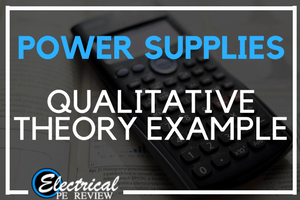Did you know, that the most common feedback about the NCEES Electrical Power PE Exam is that exam takers are often surprised at the high number of qualitative questions that appear on the exam?
A qualitative question is a test question designed to test your application of theory to select the most appropriate answer and usually does not involve any math.
There are two main types of questions on the PE exam.
Quantitative Question – A question that asks for a quantity value, typically a numerical value. It relies on using math and formulas to solve.
Qualitative Question – A question that asks for the most accurate quality or description. It usually involves no numbers.
Below is a quiz question taken directly from the Power Supplies Module in our Online Course to give you a better idea of qualitative questions and the different strategy you can use to help you solve them:
II.B.2. Power Supplies Quiz
Question 9 – Compared to a half wave rectifier, a full wave rectifier differs most nearly in that:
A) The average voltage output will be larger in value.
B) The average voltage output will be smaller in value.
C) It will require a larger peak voltage AC input signal to account for the three additional diodes.
D) The instantaneous input power seen at the power source will have a frequency twice as big as both the frequency of the instantaneous input voltage and current.
(Scroll down for the solution)

Solution:
Compare the output graph of the half wave rectifier to the full wave rectifier over the same period and you will notice that the full wave rectifier has two positive half cycles and the half wave rectifier only has one:


This means that the resulting average voltage output, also known as the DC voltage found using the below formula where F(t) equals the instantaneous output voltage function:

Will be much larger than the half wave rectifier.
The correct answer is:
A) The average voltage output will be larger in value.
Wrong Answers:
B) The average voltage output will be smaller in value.
The Opposite is true since we now have twice as many half cycles in the same period.
C) It will require a larger peak voltage AC input signal to account for the three additional diodes.
Although real diodes do exhibit a very small measurable voltage drop, it is considered negligible in power circuits. Therefore a few extra diodes do not generally require a larger AC input voltage to operate.
D) The instantaneous input power seen at the power source will have a frequency twice as big as both the frequency of the instantaneous input voltage and current.
This is true for both the full wave and half wave rectifier looking at the power source since instantaneous power is the product of instantaneous voltage and instantaneous current:
p(t)=v(t)i(t).

This article was the key that helped me work this kind of problems much much much more better
I was afraid to learn and solve problems for this topic but you made it look so simple and easy to understand. Thank you.
Electronics bin always hard to understand for me, but watching your videos really makes things more simple and easier to understand. Probably will not make me expert but defiantly changed my thinking during the problems.
Always explained clearly and concisely! Thanks for being a great resource.
This out of many other things in this course is extremely help. This material has helped me understand the basics of Power engineering. Highly recommend this course.
Zach,
Power supplies really helped me a lot. It definitely made me have a better understanding of how it works. You honestly have the gift of teaching.
Thanks for the compliment Carlos! I’m glad it has been helpful to you
The Electrical PE Review module, “Devices & Power Electronics”, was excellent. There are multiple PE Exam practice questions which ask for the correct solution output waveform based on the power electronic circuit problem. Before I took the Electrical PE Refresher course, I had great difficulty in determining what the correct output would be for those various circuit configurations. Now I can solve them both quickly and accurately. I now have a great feeling of confidence when seeing these problems and look forward to getting that much more correct answers on the PE Exam!
Thanks Jeff! I’m glad you have been enjoying the course and that it has been helpful for you.
This section has definitely strengthened my conceptual understanding of power supplies. Sometimes its easy to forget the big picture when sifting through formulas. This is a big help!
I think for most part my weakness is in qualitative problems compared to solving problems . This article really helps with that.
Zach,
This module helped me understand the concept behind FW and HW rectifiers. Thanks
This article is very well organized and exactly focuses on the heart of the topic. Great resource for passing complicated PE exam. Finding Electrical PE review was the best thing happened during my studies for the PE exam.
Thank youfor this great preparation course, Zach.
These are fundamentals examples for power supplies, it was explained in simple terms and very helpful.
Thanks
This Qualitative Practice Problem on Power Supplies has a great explanation. I loved how you walked not only through the solution BUT ALSO through the incorrect answers to explain why each was incorrect. This is the difference between your review course and others out there…the Electrical PE Review Course is leaps and bounds above those other courses.
These qualitative questions really test your knowledge on theory and I appreciate the time devoted in the lessons from Electrical PE Review to nail down your understanding of the topics. While in our live classes, Zach doesn’t mess around with this! What might seem repetitive is just looking at the topic from all angles.
This is one of the first articles I read before signing up for the course. This really helped me relax and not just read textbooks. We use formula sheets for 75% of the exam as it is, and you can reference formulas for qualitative problems as well!
This is a fantastic example of how a qualitative problem can be worked quantitatively. While NCEES is testing us on our grasp of concepts, there’s nothing wrong with using a little bit of math to get there. Thanks for the reminder that trying a little math when struggling with a conceptual problem is a valid solution.
Some of the best advice you can glean from the article about qualitative questions is to locate all of the formulas for the topic and then “chain” them together to answer the question. NCEES is notorious for taking a simple qualitative question and burying it in level upon level of jargon. Using the formulas cuts through all of the words and lets you see how the relationships change as values are increased and decreased.
Qualitative problems are the most overlooked problems on the exam. The material on Power supplies and this article really helped me overcome my fear of getting stumped on such questions.
Qualitative problems can sometime be the hardest thing to solve if you don’t under the theory or concept behind the question. Zach’s article is helpful to explain the importance to full under the questions being ask. Great article!